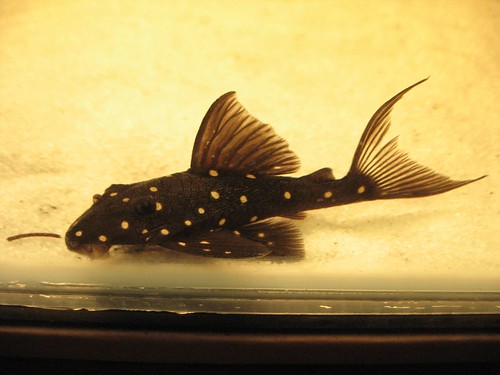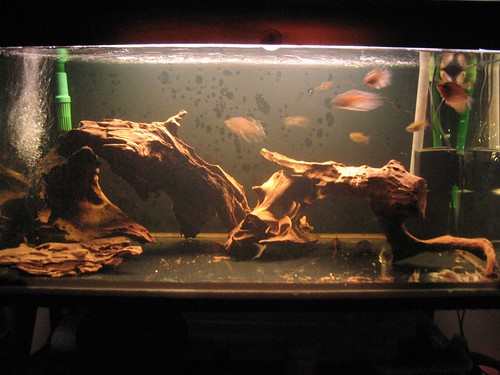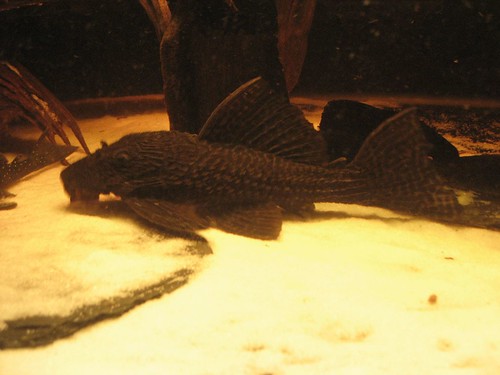Scientific Name : Hemiancistrus sp. L128
Family : Loricariidae
Common Name : Blue Spot Pleco
Maximum Length : 17cm / 7"
Origin : Rio Orinoco, Venezuela - A black water river
pH Level : 6.0 - 7.0


Things to note: L128 live in a blackwater river and hence blackwater extract or lots of wood will make it easier to acclimatize.
Personal comments : L128 is one of the more popular plecos in the world. It is one of only two blue plecos (the other being L239) and in term of personality and beauty it far outstrips the latter. It comes from the same stretch of river as the L200, and it is conjectured that they look the same (sans the colour difference) because they ARE the same, just a colour variation. My L128 is the most active (and fiercest) pleco in my tank, and moves around all day.
Tips : There are two things to look out for when choosing a L128. Firstly, it must be as well spotted as possible (such a specimen would be rare), and secondly it is more desirable to have white rims on its dorsal and caudal fins.
......................................................................................
Sexual dimporphism / reproduction : Not known.
Feeding : A look at the mouth of the Blue Phantom Pleco reveals that this species is an "Aufwuchs" eater. Aufwuchs is the organic layer, part plant, part animal (small crustaceans, fresh water sponges, small insects and their eggs, plankton), that over time develops on submerged surfaces. The fish uses its large diskshaped suckermouth, equipped with a large amount of tiny teeth, to graze on these surfaces. Once acclimatized, this species of Loricarid will usually readily accept meaty foods (bloodworms, mosquito larvae, artemia, tubifex) as well as vegetable matter (vegetables, pellet food, algae and, to the dismay of many aquarists, also aquarium plants). The emphasis should be on vegetable matter, as a diet that is too proteine-rich can lead to digestive problems, ingestation and bloat.
Behavior in captivity : This medium-sized Loricarid prefers a dimly lit tank with a good number of hiding places, either created with plants, drift wood, rocks or artificial (pleco spawning) caves. To keep more than one adult specimen in the same tank, or together with other bottomdwelling fish, you need at least a 48x20" (120x50 cm.) tank or larger: this fish can be quite territorial, and when suitable hiding places are lacking, it can be agressive towards other bottom dwellers. When kept as only catfish in an aquarium, a tank size of 40x16" (100x40 cm.) is sufficient, although a 48" (120cm.) aquarium would be better.
L128 requires warm and very oxygen-rich water, preferably soft and slightly acidic water (pH 6.0-6.5). Also, lots of underwater currents are appreciated. A powerful filter system is recommended, as this fish produces a lot of waste.



 - Rio Sao Francisco, Brazil
- Rio Sao Francisco, Brazil - Rio Sao Francisco, Brazil
- Rio Sao Francisco, Brazil
 Things to note: L282 is a beautifully adorned pleco that rarely comes even during the export season. As it is a spiked pseuda do take note that it will have a huge temper to match its beauty.
Things to note: L282 is a beautifully adorned pleco that rarely comes even during the export season. As it is a spiked pseuda do take note that it will have a huge temper to match its beauty. Things to note: The Golden Nugget is very beautiful fish, and relatively undemanding.
Things to note: The Golden Nugget is very beautiful fish, and relatively undemanding. Things to note: The Snowball Pleco is interesting to keep and is best identified by its teeth, which are made up of four large rasping plates.
Things to note: The Snowball Pleco is interesting to keep and is best identified by its teeth, which are made up of four large rasping plates.
 Things to note: A man-made variant of the Common Bristlenose, the Long fin Ancistrus is commonly captive bred. It appears impossible to identify to species primarily due to a lack of original locality information .
Things to note: A man-made variant of the Common Bristlenose, the Long fin Ancistrus is commonly captive bred. It appears impossible to identify to species primarily due to a lack of original locality information .
 Things to note: L160 is one of the sharp spiked and spotted pseudas. Hence it is extremely boisterous and territorial, and care must be taken to ensure that there is sufficient space for it to call its own. Aeration and pH are also important factors. The flow rate of the powerhead is not important. Note that young fish are extremely sensitive to ammonia and nitrite, and overfiltration is always recommended.
Things to note: L160 is one of the sharp spiked and spotted pseudas. Hence it is extremely boisterous and territorial, and care must be taken to ensure that there is sufficient space for it to call its own. Aeration and pH are also important factors. The flow rate of the powerhead is not important. Note that young fish are extremely sensitive to ammonia and nitrite, and overfiltration is always recommended. Things to note: With its mazy and attractive patterns this pleco makes a good tankmate in a small pleco comm tank.
Things to note: With its mazy and attractive patterns this pleco makes a good tankmate in a small pleco comm tank. Things to note: One of the most popular peckoltia species in the market, Leopard Frog Plecos are one of the species that have been bred successfully by hobbyists.
Things to note: One of the most popular peckoltia species in the market, Leopard Frog Plecos are one of the species that have been bred successfully by hobbyists. Things to note: The "brother" species of L600, there are a lot of similarities between the two species. The most accepted difference is that on a L114 the spots are even throughout the body, while on a L600, the spots get smaller or disappear on the head portion. L114 also has a smaller maximum size compared to a L600.
Things to note: The "brother" species of L600, there are a lot of similarities between the two species. The most accepted difference is that on a L114 the spots are even throughout the body, while on a L600, the spots get smaller or disappear on the head portion. L114 also has a smaller maximum size compared to a L600. Things to note: One of the easiest plecos to recognise and keep, the Mango Pleco is a traditional favourite among pleco keepers, and is easy enough to start with. The yellow fins against a green background cuts a beautiful sight in any tank.
Things to note: One of the easiest plecos to recognise and keep, the Mango Pleco is a traditional favourite among pleco keepers, and is easy enough to start with. The yellow fins against a green background cuts a beautiful sight in any tank. Things to note: This is the highfin variant that is much sought after by hobbyists. It is easily recognisable by its mustard green body with yellow spots, and a wondrous dorsal fin that when fully extended, opens up perpendicularly to the body.
Things to note: This is the highfin variant that is much sought after by hobbyists. It is easily recognisable by its mustard green body with yellow spots, and a wondrous dorsal fin that when fully extended, opens up perpendicularly to the body.
 Things to note: L14 looks very different as a juvenile fish and as a adult fish. As one of the most popular plecos in the market it is good for beginners.
Things to note: L14 looks very different as a juvenile fish and as a adult fish. As one of the most popular plecos in the market it is good for beginners.
 Things to note: This is another species for which there is very little literature available on the Internet. However it is famed for its gentleness and beauty, and it is one of the more popular choices for experienced and deep pocketed hobbyists.
Things to note: This is another species for which there is very little literature available on the Internet. However it is famed for its gentleness and beauty, and it is one of the more popular choices for experienced and deep pocketed hobbyists.


 Things to note: Royals are consistent in one thing: they defecate a lot, and will be a huge tax on the filtration system. Always overfiltrate when keeping Panaque because of their wood eating nature.
Things to note: Royals are consistent in one thing: they defecate a lot, and will be a huge tax on the filtration system. Always overfiltrate when keeping Panaque because of their wood eating nature.

















